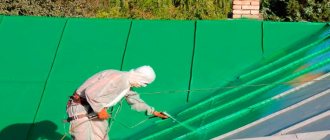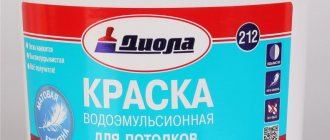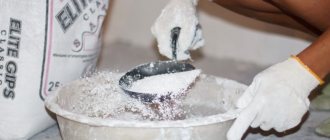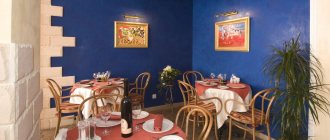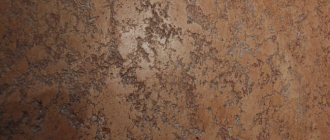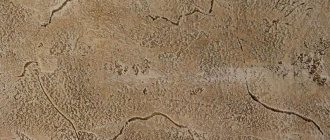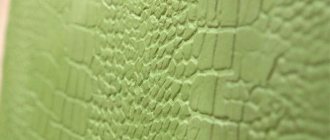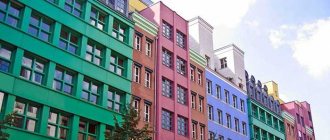Stucco Veneziano – marble walls from Venice
Almost every fan of a stylish interior strives to buy Venetian plaster. Among the abundance of decorative materials, only one veneziano can give the walls a smooth marble look and strength comparable to natural mineral. And all this at a very affordable price, less than 500 rubles. per sq.m. Venetian plaster is suitable for any interior style, be it modern minimalism or luxurious classics. It’s not for nothing that she is called the queen of decorative coatings. In the photo in our gallery you can see examples of finished works.
The journey of Venetian plaster to Russia
The Venetian woman gained particular popularity in the romantic but “raw” city of Venice. Numerous canals repeatedly flooded its facades, and high humidity contributed to fungal infection.
Residents needed to decide: what to cover the walls of their houses with in order to protect them from the formation of mold. It turned out that there is no better material than lime plaster, and the low cost of the composition made it possible for people with different incomes to buy it.
For Moscow and central Russia, Venetian is more of a decorative plaster for interiors, rather than for facades. Today, buyers have the opportunity to purchase both classic Venetian plaster, the composition of which has not changed for several centuries, and acrylic - rich in improving ingredients, but with some differences.
How to avoid bloating
Painting begins after the plaster has completely dried. The surface must be dry and clean. Bubbles appear when a subsequent layer of paint is applied to a wet base. The drying time should correspond to the selected type of paint. Roughness must be carefully removed by careful sanding using sandpaper. The paint must dry completely.
See also
11 best solvents for oil paint and how to thin it yourself
High humidity and room temperature slow down the drying of paint. If the layers have differences in thickness, then during drying stresses will arise between them, which can stretch the surface film and form a bulge.
The battle between classics and acrylic: which is better?
What kind of material to buy for wall decoration depends on the designer’s idea, budget and client’s wishes.
For a coating that has the maximum resemblance to a natural marble surface, you need classic Venetian plaster with air-lime, which is applied to previously prepared and carefully leveled walls (by eliminating defects, sanding, covering with putty, and then impregnating).
Such work is sometimes carried out by a master of artistic design, who draws in detail the original marble patterns, down to barely noticeable veins. Of course, the services of an artist will increase the cost of finishing work.
If the ideal accuracy of reproducing the marble texture is not important, then it is better to buy acrylic decorative plaster. Made from environmentally friendly water-based latex, it has the same strength characteristics as its limestone counterpart. And together with protective wax, the coating becomes invulnerable to moisture, so it is used for finishing walls in damp rooms - bathrooms, showers, etc.
Color Update
If desired, you can change the color of the decorative plaster. The presented option will allow you to update the interior design, as well as decorate the room at minimal cost.
To do this, just select the color and choose the method of painting the plaster.
Plain coloring
Paint selection
The most important step when updating your wall colors is choosing paint.
It is necessary to purchase the coloring composition of the brand that was originally used when decorating the premises. However, even in this case, the shade may differ, so it is recommended to completely repaint the walls.
When performing indoor work, an acrylic or water-based base is suitable. It is necessary to purchase a sufficient amount of material so that it is enough to decorate the entire surface.
For the facade of buildings it is necessary to select paint that is resistant to environmental influences. In this case, it is best to use coloring compositions based on silicone or silicate components.
Options for painting with improvised means
Painting options
You can paint the wall locally or completely; the choice will depend on the amount of damage, the features of the new design, as well as the quality of the preserved base.
Relief plaster can be painted in several ways:
- First, the entire surface is covered with one color. And then lightly wipe off the paint from the protruding parts with a dry sponge.
- Painting with a semi-dry brush - lightly dip the brush into the paint, remove excess. And walk over the surface with such a brush, deliberately not painting the wall completely.
- Two-color painting - we cover the entire wall with one color, and then use a roller to paint only the protruding parts with a different color.
Using a semi-dry sponge, color is applied to the protrusions.
Smooth walls can also be painted not only in a single color:
- You can use decorative rollers that leave patterns on the wall.
- Decorative paints or thin-layer plasters, with the effects of “silk”, “velvet”, “velor”, etc.
- Using several matching shades you can create geometry on the walls. All you need is masking tape.
Golden glow or noble mother of pearl
Venetian-decorated walls become mirror-smooth. You can never achieve a similar effect with paint or wallpaper. The texture design is always exclusive, because the wall is created spontaneously, at the hand of the master. Overlapping each other, several thin translucent layers create a fantastic, unique pattern:
— Veneto – classic Venetian plaster, made with the best lime, aged for 36 months after slaking. This makes the finish unsurpassed in hardness and beauty of the pattern.
— Encausto – for an impeccably smooth, artistic “marbled” finish with piquant terracotta ripples.
— Imperiale – to give the walls a delicate, sophisticated golden shine. An inexpensive way to showcase luxury walls.
Order finishing to professionals or do it yourself
Due to its aesthetics, durability and versatility, Venetian plaster has rightfully become a favorite material among designers, the price of which depends on 3 factors:
1. The number of layers applied (the more, the more expensive the walls will be). Typically, a 3-layer application is sufficient to create a realistic marble pattern with a high degree of smoothness.
2. Time spent by the master.
3. Hiring a specialist for artistic finishing. To avoid getting into an unpleasant situation, you should ask the person for a portfolio in advance - it’s easier to judge their qualifications based on photos of the work they’ve done.
The affordable cost of Clavel Venetian plaster, as well as the availability of photos and videos with step-by-step instructions, make wall finishing not a complicated process, accessible not only to professionals.
Tinting
Decorative plaster, sold in the form of a dry mixture, is white or gray in color. It can be colored immediately when mixed with water. To do this, use tinting aqueous solutions or pastes, which are added directly to the container with plaster. The amount of color depends on the desired color saturation. Addition occurs with constant stirring. This is the simplest method of painting decorative plaster, used to obtain the base color of the walls. Tinting has its advantages over painting the surface in that later scratches and chips of the plaster will be less noticeable.
Buy at a profit
In Moscow you can buy Venetian plaster at very attractive prices: magnificent marble walls will cost you no more than 2,000 rubles per sq. m. meter along with the cost of work, and will last at least 15 years.
In addition to the affordable price, you will undoubtedly appreciate:
- impressive showiness, beyond the reach of paint, tiles and the most expensive wallpaper.
— high quality products;
— safety for people and animals (unlike toxic paints);
— resistance to mold even in damp rooms;
Classic and acrylic plasters are sold in Clavel partner showrooms in 76 cities of Russia. By opening the price list, you can find out in advance how much the plaster mixture costs to create a particular effect.
Everyone wants to make their home unique. Therefore, wall decoration is always selected very carefully. There are many options: both expensive and quite economical. Painting walls in the “Venetian paint” style is an opportunity to create the effect of decorative plaster in your home or apartment for little money.
Choosing a dye
In some cases, it is more advisable not to paint the plastered surface, but to apply decorative plaster with an already selected shade. To do this, pigment dye is added directly to the plaster mixture.
The color pigment is added separately to the plaster dye.
Tinting must be done on the entire composition at once - otherwise it will be difficult to select the same shade for re-preparing the composition. For example, for cement plaster you can use any concrete dye, but for a polymer mixture it is recommended to use an acrylic-based color.
A simple way is to add a universal dye to the plaster mixture.
When purchasing dyes for plaster, it is recommended to pay attention to the packaging labeling, which will indicate what kind of work the color is intended for (interior or exterior decoration), what type of plaster (for concrete, polymer, gypsum, cement).
Pay attention to: How and with what compositions a wooden fence is painted
What is Venetian plaster
This is one of the options for finishing walls. The end result is an exquisite surface that transforms an ordinary home into a unique one. To apply Venetian, you need to have specific knowledge and experience, so the work of masters is always expensive. Attempts to repeat their actions usually end in failure.
Therefore, an option from the “cheap and cheerful” series appeared - to imitate the effect of Venetian plaster using paint. To do this, as it turned out, is not so difficult. Labor costs are low, the price of consumables is affordable for almost everyone. The only thing left to do is to understand what the surface should be like.
The most popular and in demand are mixtures of Venetian plaster in noble natural shades. With their help, a surface is created that imitates the surface of natural stone:
- "Malachite" - emerald color;
- “Granite” – gray color;
- “Marble” – white, pink.
Also, with the help of Venetian plaster, you can achieve the effect of golden brocade (a mixture of noble blue, green, burgundy colors with gold).
The material is demanding on surface quality. The same can be said about painting walls with “Venetian paint”. Therefore, the preparatory stage cannot be avoided.
Surface preparation
Working with Venetian plaster requires a certain skill and dexterity. Many finishing specialists consider performing such an operation to be the pinnacle of their qualifications. The process even requires certain tools. Such as the Venetian trowel.
Otherwise, you need the usual set of:
- construction mixer;
- ironers and rules;
- soil rollers;
- thin spatula;
- sandpaper;
- a piece of suede;
- rubber spatula for wax.
Venetian plaster fits well on walls made of any material. An indispensable condition is a surface brought to the ideal. After all, a thin layer of coating will only expose all the imperfections, nullifying all efforts. Even the slightest crack will stand out clearly against the general background. And if you remove defects with a finishing composition, then this is comparable to throwing a lot of money down the drain, since the material is not cheap.
Cleaning walls before puttyingSource ya-superpuper.com
Therefore, the walls are checked and then leveled using conventional putties. Moreover, the solution must be applied in two layers. And at the final stage it is necessary to clean the wall with sandpaper. Next, the surface needs to be primed.
To do this, use a brush or roller. The second option will allow the operation to be carried out faster and the soil to be placed more evenly. Untreated areas should not be allowed. The composition to subsequently improve the adhesion of the plaster is applied in two layers. Or they use different ones. First, a deep penetration primer is applied, and then a finishing coat is applied. Allow the first coat to dry thoroughly before applying the final coat.
There are rare cases when leveling a wall with putty is extremely difficult. Then a plasterboard surface is created, which also needs to be prepared to accept Venetian plaster. The constructed wall is primed, puttyed and rubbed to perfect condition.
Latex paint coating technology
To achieve the result, a special application technique is used. It is also necessary to accurately select the ratio of dark and light colors. For the finishing touch, you can take silver or gold paint and use it to make the surface of the walls in relief, creating unique patterns using a crumpled plastic bag.
Tools and materials
To prepare a perfectly flat surface and obtain the required result (painting an interior wall or ceiling), you will need the following tools:
- spatulas of various sizes;
- foam roller or plastic bag;
- trowel;
- sponge for drawing;
- rags for removing paint drips;
- containers for water and mixtures;
- construction mixer;
- a large bucket of water;
- natural sea sponge (not synthetic);
- colored water-based paint of various shades;
- paint tray;
- old cellophane to cover the floor from paint;
- masking tape;
- brush.
What tools will you need?
To work you will need the following painting tools:
- Rollers . Foam rubber is used only for working with water-based paints. Rollers with a fur coat pick up a lot of paint and are suitable for creating a textured surface. The smoother the plaster, the shorter the pile. For a textured surface, choose a roller with a pile length of 15-20 mm or more. For work, it is worth purchasing a telescopic tube-handle, with which you can easily reach any corner.
- Brushes are wide, flat, with synthetic or natural bristles. For decoration you need a brush - a large brush with soft bristles. Small round brushes are useful for working with stencils.
- Sponges - foam rubber and natural. Needed to create decorative effects.
- Trays for paint and varnish.
- Film and masking tape to protect floors and baseboards.
- Paper for painting.
- Spatulas - for mixing paint.
- A spray gun is not such a necessary tool, but if handled skillfully it will save time and reduce paint consumption.
Tools for working with decorative plaster
Fast Forward TIP : if you have to work with several colors, then prepare a couple of sets of brushes, rollers and trays so as not to mix the paint.
Oil paint coating technology
Walls for finishing must be prepared in the same way as when working with latex paints. Here are the differences:
- Cover the prepared wall with transparent paint of a slightly pinkish tint.
- After the first layer has dried, apply the second.
- Prepare glaze (translucent) paint.
- Divide the wall (mentally) into strips of short length (10 centimeters).
- Using a medium-sized paint brush, apply stripes of paint to the wall.
- Rub the paint onto the wall with a wool rag. The more chaotic the movements, the better.
- Go over the wall with a dry, soft-bristled brush. This will help blend the paint well.
- Wait until the surface is completely dry.
To prepare glaze paint you will need linseed oil, turpentine + drier (you need to add just a couple of drops of drier to turpentine), oil paint (tube). The ratio of linseed oil and diluted turpentine is 1:2. Mix the ingredients until a homogeneous composition is obtained. Add half a tube of oil paint and rub until the desired color is uniform.
Choose a shade such that the imitation of Venetian is as close as possible - light ocher, natural sienna, umber, brown mineral pigment (natural clay). The last two shades will help create a mixture that perfectly imitates natural marble, right down to the veins.
Using latex or glaze paints, without spending much effort, you can imitate Venetian plaster on the walls and ceiling of your home. It is important to choose the right ratio of colors and their shades. The paint does not have the effect of depth, this quality is characteristic only of the Venetian. Therefore, it depends on the chosen color whether the room will visually increase or, on the contrary, decrease.
Suitable formulations
The coloring composition is selected depending on the type of wall covering (plaster, plasterboard, wood), temperature and humidity in the room being decorated.
Acrylic
Acrylic paints are an aqueous solution of polymer dyes. It forms good adhesion to surfaces, does not crack due to temperature changes, and is easy to apply and shade over the surface.
Latex
Latex paints are water-based and have similar quality characteristics to acrylic paints. The compositions are non-toxic, odorless, and form a breathable (air-permeable) coating.
Oily
Solvent-based or artificial drying oil paints. When working, they require compliance with safety rules: ventilation of the room during and after work, protection of the skin.
Features of the material
Attractive appearance A skillful imitation of a marble cut can be achieved thanks to the translucency and high plasticity of the composition, which includes organic and inorganic dyes. Decorating the walls with Venetian plaster makes it possible for even a small room to look with a touch of solemnity and grandeur. However, the result largely depends on the specialist, his skill and skills.
Wear resistance and long service life Following the rules of application technique ensures unprecedented resistance of the wall covering to long-term mechanical loads and contamination. That is why it is not forbidden to use Venetian plaster for finishing facades.
Environmentally friendly Plaster does not smell of anything and can be used without fear in any residential or public space. Residents, employees and clients are not in danger. Absolutely harmless composition, without chemical additives, does not have a negative effect on the human body.
Moisture resistance and fire safety Water-repellent characteristics simplify maintenance: any available detergent will do an excellent job of cleaning the surface. Dried material is not subject to fire.
Cost per sq. meter.
The products included in the catalog have different compositions and technical characteristics. Each type creates a unique effect, which allows you to choose the material that suits your wishes.
- Encausto. Recreates a marble structure interspersed with terracotta. Price from 880 rubles per sq.m.
- Imperiale. Decorative gilding effect; Price from 670 rubles per sq.m.
- Marbella. An interesting combination of shiny and matte marble cut; Price from 460 rubles per sq.m.
- Marmorella. Lime with marble inclusions in beige and gray shades is an exclusive solution; Price from 1380 rubles per sq.m.
- Tierrafino. Imitation of marble surface combined with other natural materials; Price from 925 rubles per sq.m.
- Trevignano. Semi-synthetic plaster creating the effect of polished marble; Price from 445 rubles per sq.m.
- Veneto. Like polished marble. Natural lime (curing period 3 years) Venetian plaster price from 750 rubles per sq.m.
Order method
We advise you to first calculate in the calculator the cost of the materials needed for your wall area. The estimate is calculated in full, taking into account the preparation of the base and tinting in the required color. To buy Venetian plaster, put the item you are interested in in your office and place your order. Our specialists will contact you to agree on a delivery date.
To contact our managers, use:
- contact number:
- online chat;
- email;
- order a call back;
- personal visit to the office located at:
Our consultants will answer all your questions and describe in detail the features of Venetian plasters, the rules for their preparation, application, and further care. We are always in touch!
Clavel-Trade LLC 127550, Moscow, st. Pryanishnikova 23a 8(499)399-37-51 8(499)399-37-52 8(4822)75-02-70
